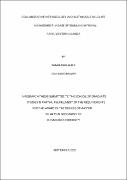| dc.contributor.author | Namulemo, Alice | |
| dc.date.accessioned | 2022-03-15T08:43:53Z | |
| dc.date.available | 2022-03-15T08:43:53Z | |
| dc.date.issued | 2021-09 | |
| dc.identifier.citation | Namulemo, Alice (2021). Collaborative methodology and sustainable wildlife management: a case of Semuliki National park, western Uganda. Kyambogo University(Unpublished work). | en_US |
| dc.identifier.uri | https://kyuspace.kyu.ac.ug/xmlui/handle/20.500.12504/864 | |
| dc.description | xiv,98 p. | en_US |
| dc.description.abstract | The study was about collaborative methodology and maintainable wildlife management in Uganda. It is vital for all interested parties in wildlife management to work in mutual support to avoid the lessening of natural wealth in order to preserve the environment. The collaborative methodology and maintainable wildlife management are accepted as important because of the need to create trustful links amongst the wildlife managers and the neighboring societies. However, challenges of maintainable wildlife management recognize, among other things; poor government procedures and failure of collaborative protection. The objectives of the study were to find out the local communities’ contribution to cooperative strategies; to establish the local community level of awareness about cooperative strategies; and to examine the local communities’ perception about the cooperative strategies as far as maintainable wildlife management was concerned. The study engaged a cross sectional design. Data were assembled to judge whether the collaborative methodology could successfully maintain wildlife management in National Parks. Qualitative and computable investigation methods were used for the study. Questionnaires, focus group discussions and interview guides were used for data assembly. The interview guide was used to gather material from 200 household heads. Both content validity (0.7) and reliability at reliability value (0.84) were ascertained. A total of 200 questionnaires were administered and all were brought back. The returned questionnaires were entered using SPSS. Descriptive statistics specifically; frequencies and percentages were used to refer to the data from the questionnaires and to take a broad view of the discoveries. The outcomes displayed that it was key for the local community to contribute to cooperative strategies. In addition, the local community level of awareness about the cooperative strategies and the local community perceptions were vital in maintainable wildlife management. Lastly, the study concluded that the local communities’ contribution to cooperative strategies, their level of awareness and their perceptions about collaborative strategies were required to manage wildlife at a maintainable level. The study suggested that the park specialists should increase on the household heads’ contribution to sustaining Mauritius thorn hedges in order to increase partnership in the execution of maintainable wildlife management. Additional household heads needed to unite in planting chili as a substitute livelihood provider in order to stop elephants from confronting the community. | en_US |
| dc.language.iso | en | en_US |
| dc.publisher | Kyambogo University(Unpublished work) | en_US |
| dc.subject | Wildlife management | en_US |
| dc.subject | Semuliki National park | en_US |
| dc.subject | Western Uganda | en_US |
| dc.title | Collaborative methodology and sustainable wildlife management: a case of Semuliki National park, Western Uganda | en_US |
| dc.type | Thesis | en_US |

